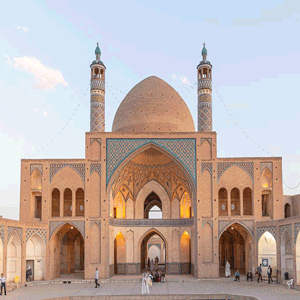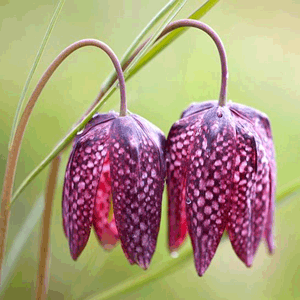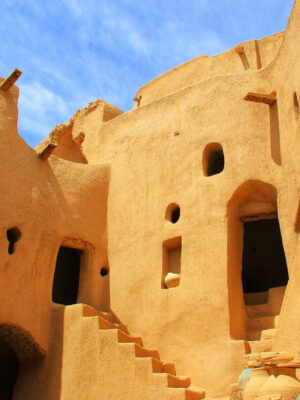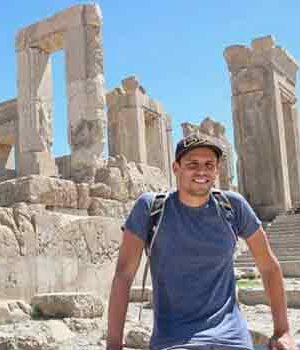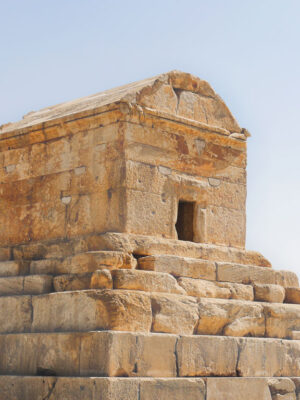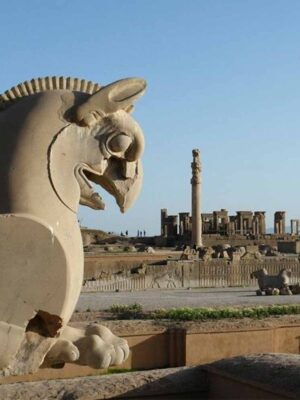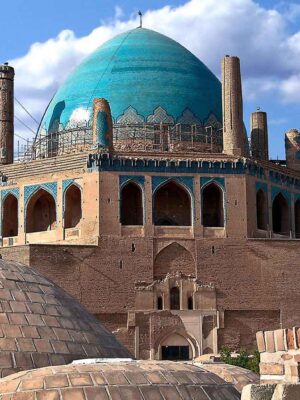Shah Cheragh Shrine
Iranians consider the people of Shiraz as the most friendly and hospitable people in the whole country. Home to great Persian poets, Hafiz and Saadi, Shiraz is also famous for the poetic taste of its population. Even the neighboring cities regard their down-to-earth social behavior, their kindness, and rich culture as a source of pride and envy. These qualities are surely reflected in the architecture of Shah Cheragh Shrine. This holy site is the burial ground of two brothers of Ali al-Reza the 8th Imam of Shia. Beloved by the locals as part of their ancestral heritage, the place has an elegant yet simple design, blending in with the culture of Shiraz.
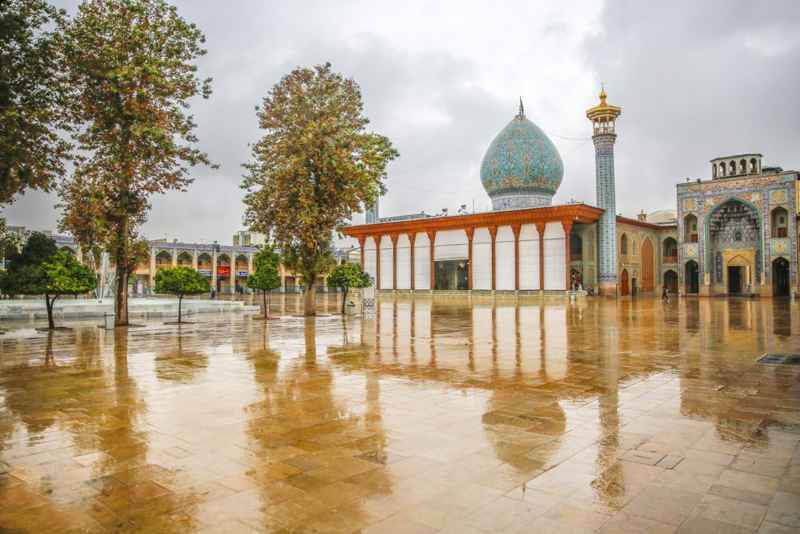
Shah Cheragh Mosque and Its Courtyard in a Rainy Day
Shah Cheragh Myth
A word-for-word translation of Shah Cheragh would be “King Lantern”, an unusual name for a religious site. The story has it an old woman reported the sighting of a magical lamplight in an inhabited part of town. She told the governor (called “King” by the people), she ran out of her house several times to find the source of the light but has found nothing. The king’s entourage made fun of the old woman. They disregarded her report as a desperate attempt to get some money from the king.
But the king, being a just ruler, decided to verify the old woman’s claim. So he went to the old woman’s house and slept in the night. In the middle of the night, the old woman saw the light and hurried to the sleeping king calling “King! Lantern!”. The king woke up and went out to find the source but found nothing. This repeated seven times that night. The morning after, the king ordered his men to dig around the place where she saw the light. His men found a crypt and a body buried within.
That night the king dreamt he was visiting the Holy Shrine of “Ahmad son of Musa al-Kazim”. The king verified the truth of his dream by consulting with clerics. He then ordered a magnificent building to be constructed as a shrine for Ahmad son of Musa al-Kazim, who became famous later on as Shah Cheragh.
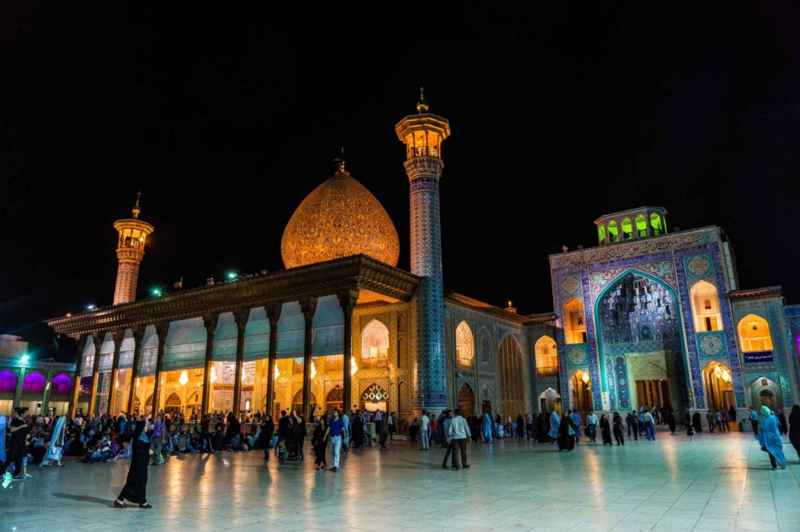
Shah Cheragh Mosque at Night
History of Shah Cheragh
The original building is believed to have been built around 1130 A.D. during the rule of the Seljuk Empire. However, it was a very simple design consisting of the tomb chamber, a dome, and a colonnaded porch.
200 years later, Queen Tashi Khatun made noticeable improvements, made repairs, and added an edifice, a collage, and a tomb for herself. Tashi Khatun attended the holy site every Monday along with a crowd of people for pilgrimage. Making the holy site more popular by her constant attendance.
In 1324, an influential cleric discovers the body of another brother of Imam Reza, Mirza Mohammad. He financed the construction of a second mosque and a tomb chamber for the discovered body which shares the same courtyard with Shah Cheragh Shrine.
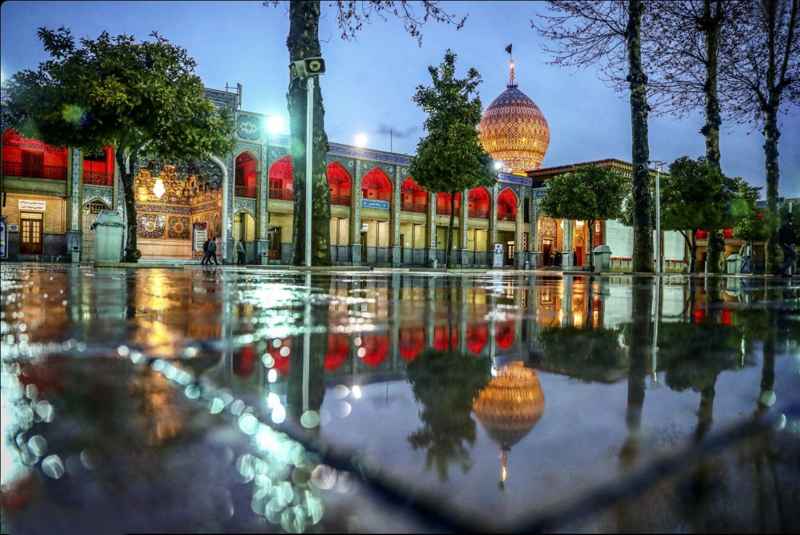
Mirza Mohammad Shrine Sharing Courtyard with Shah Cheragh Shrine
Later Years
In the ensuing years, earthquakes inflicted damage to these buildings, and kings of different dynasties oversaw the necessary repairs. Nader Shah Afshar (ruling from 1763 to 1747) significantly improved the decoration after his victory against invading Afghans. Most notably, he ornamented the Shah Cheragh interior with a large golden chandelier. In 1823, a huge earthquake leveled the entire city of Shiraz and turned the whole site into rubble. After that, guardians of the shrine sold the golden chandelier to fund the reconstruction of the Shah Cheragh Shrine.
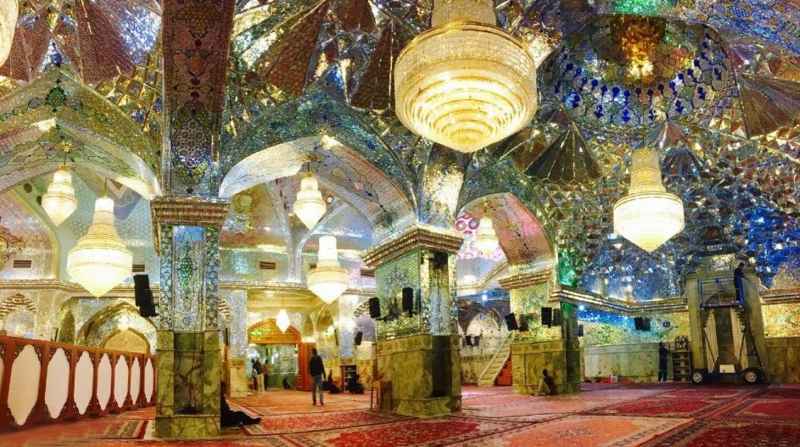
Shah Cheragh Interior
Qajar dynasty also contributed significantly to the reconstructed shrine. In 1827 Fath-Ali Shah Qajar endowed a silver tomb chamber to the Shrine. The extensive mirror ornamentation was carried out during the rule of Naser al-Din Shah Qajar.
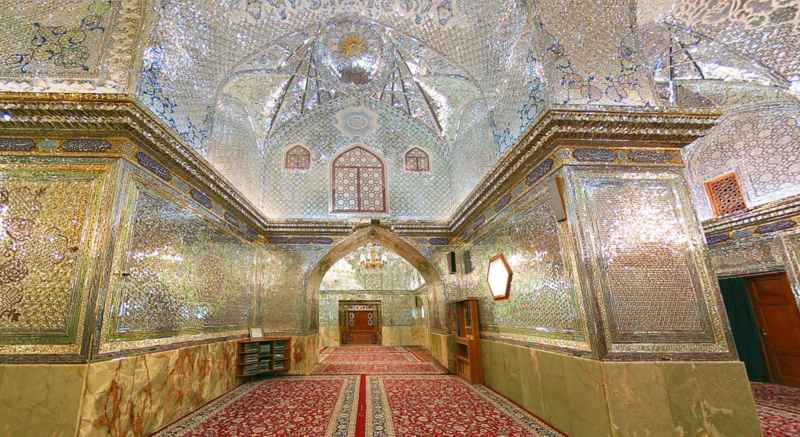
Shah Cheragh Interior
The writings around the tomb chamber of Shah Cheragh are poetry written in Farsi and Arabic. The tomb used to contain an old handwritten copy of the Holy Quran probably written by Imam Ali the first Imam of the Shia. The Quran now resides in Pars Museum for better preservation.
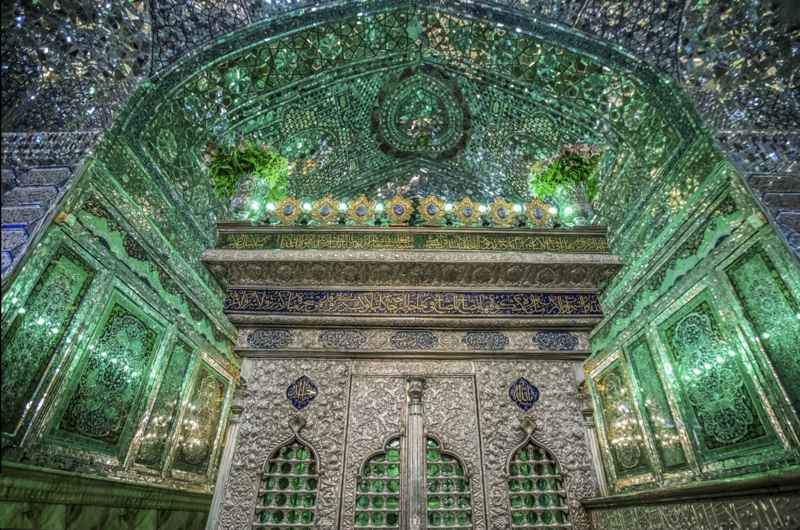
Tomb Chamber of Shah Cheragh (Ahmad son of Musa)
The mirror ornamentation turned the interior of the Shah Cheragh Mosques, into jewels. It is still mesmerizing the visitors and pilgrims with its beauty. Above all, supplementing the holiness of the structure with the lighting effect it provides.
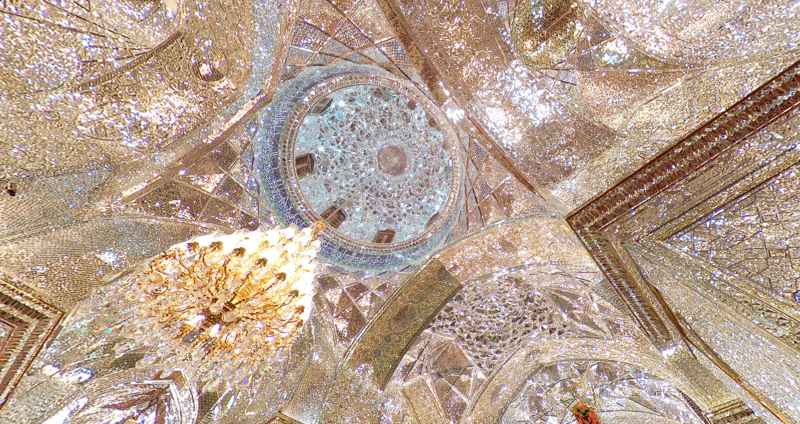
The ceiling of Seyed Mir Mohamad Mosque
The last Shah of Iran, Mohammad-Reza Pahlavi also made his contribution to this site. During his rule, the old dome was replaced with a more durable one that had the benefit of a metal structure. Therefore, making it more resilient and durable.
Shah Cheragh Museum
In addition to the mosques and two courtyards, the shrine has its museum as well. The museum, opened to the public in 1965, contains about 8000 artifacts of archeological importance. Yet, due to the rather small size of the gallery, it exhibits only about 600 of them at a time. These artifacts include earthenwares dating back to the 2nd and 3rd millennia B.C.E. There are also earthenwares from the Arsacid and Sassanid eras.

Shah Cheragh Museum – Main Gallery
Museum also exhibits metalworks dating back to the 1st millennia B.C.E. amongst these artifacts perhaps the collection of vitreous enamels is most notable. Spearheads, locks, and other metal artifacts are also on display at the gallery. Shah Cheragh Museum also contains a wealth of glassworks of the Sassanid epoch along with a large collection created in the Islamic era. Coins dating back to the Arsacid and Sassanid eras, along with a complete collection of Coins and PaperMoney minted afterward are amongst the important possessions of the museum.
The old silver, gold, and enameled doors of the tomb chamber of Shah Cheragh are also noteworthy. Endowed to the shrine by Qajar Princes and rulers are on permanent display for visitors to bask in their beauty.
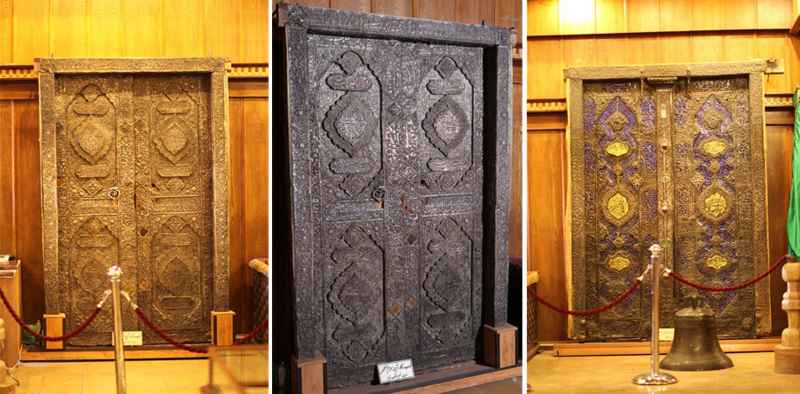
The Old Tomb Chamber Doors Endowed by Qajar Princes
Shah Cheragh, a Public Heritage
While the beautiful architecture and ornamentations of this place are marvelous on their own, they can only be fully appreciated when the live interconnection of the Holy Site and its pilgrims are grasped by the visitor. The surviving relationship which gives life to the building and enriches the visitors of all ages is one of the most remarkable qualities of Shah Cherah Shrine. Much like Imam Reza Shrine, this place takes identity, beauty, and definition from the people. And yet, it gives it all back to the living culture. Such relationship takes its most unique form in a ceremony called “Laleh Gardani” which translates to “Marching Tulips”.
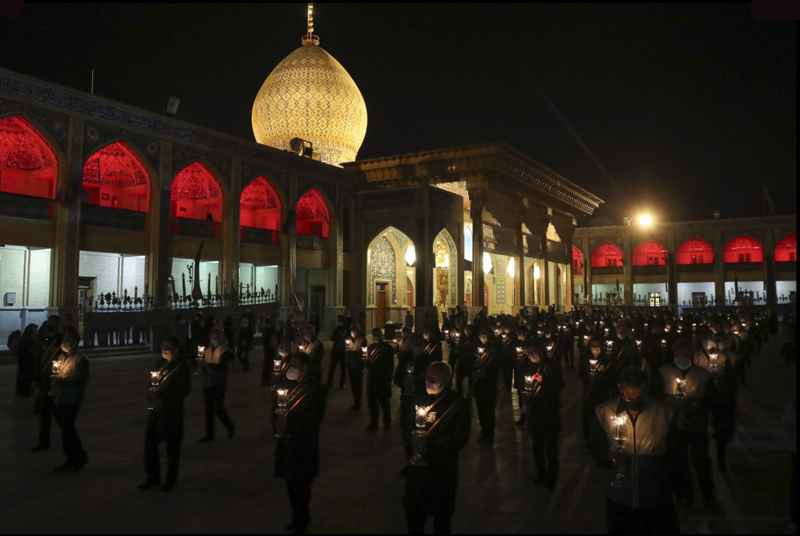
Pilgrims Marching in the Courtyard of Shahcheragh Holding Candle Lanterns
In the ceremony of “Marching Tulips”, men, women, and children march in the courtyard holding tulip-shaped lanterns and mourn the martyrdom of Imam Reza and his brothers. The unison of the crowd, the lighting effect created by moving lanterns, and the empathic atmosphere of the crowd can not be put into words in such a short article. One has to experience this somber march of shadows and lights firsthand to fully comprehend the relation between “King Lantern” and his pilgrims.
The Antique Mosque of Shiraz
Adjacent to the courtyard, there is yet another mosque that is much older than the two described above. It was built in 894 over a much older structure probably belonging to the Sassanid era. While this third mosque is not part of Shah Cheragh Shrine, it helps the visitor to understand the development of architecture through the ages. It also contains its attractions; Firstly, The Nodbeh wall in the southern wing of the mosque which people believe to be where the journey of Prophet Muhammad to the heavens starts from.
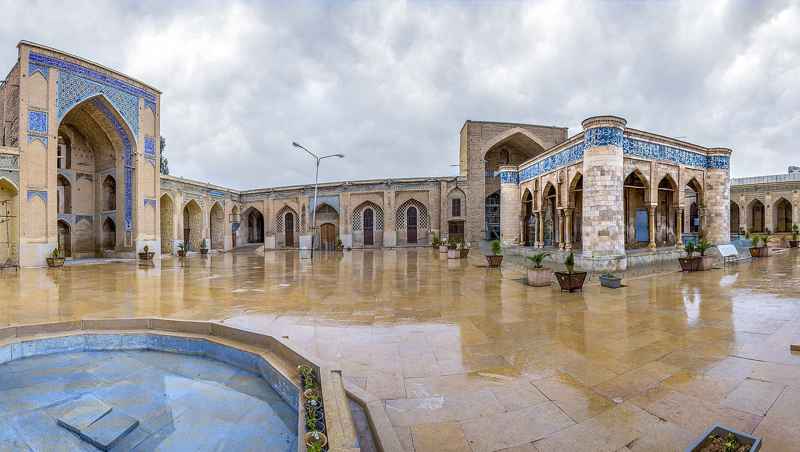
Mosque of Atigh in Shiraz
The other is the cubic structure of “khodaykhane” which translates to “God’s house”. This building used to be a place for creating handwritten copies of the Holy Quran before the invention of printing machines. There is a folk rumor that the sleeping dragon belonging to the Prophet Moses sleeps underneath it.
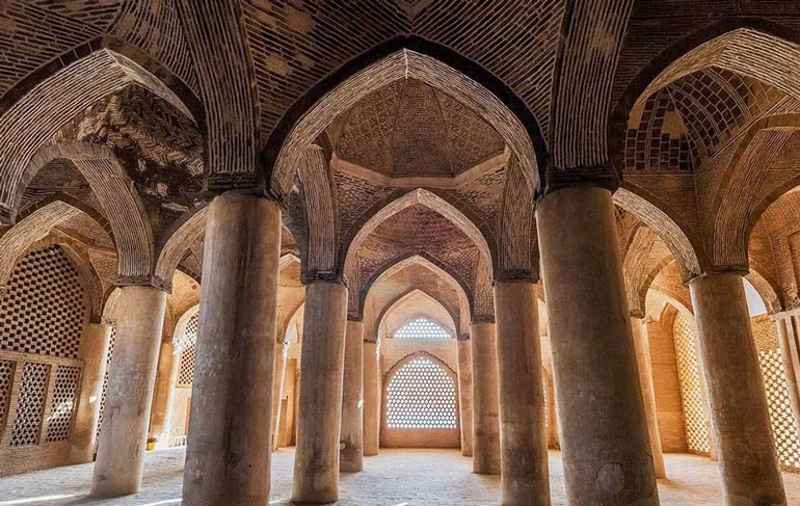
Mosque of Atigh in Shiraz – Interior View
Best Time to Visit
The best time for visiting Shah Cheragh would be the Nowruz holidays. But if you prefer a less crowded time, the month of May would please you more. Much like other religious sites, the cultural significance and relation to people can be best observed at ceremonies like Ashura, or during Ramadan. Yalda Night also provides a good opportunity to have a memorable experience from your visit. You can also enjoy the virtual tour at any time by clicking here. For reservations and more information about our tours, please contact us at Pasargad Tours.
Shah Cheragh Shrine
Iranians consider the people of Shiraz as the most friendly and hospitable people in the whole country. Home to great Persian poets, Hafiz and Saadi, Shiraz is also famous for the poetic taste of its population. Even the neighboring cities regard their down-to-earth social behavior, their kindness, and rich culture as a source of pride and envy. These qualities are surely reflected in the architecture of Shah Cheragh Shrine. This holy site is the burial ground of two brothers of Ali al-Reza the 8th Imam of Shia. Beloved by the locals as part of their ancestral heritage, the place has an elegant yet simple design, blending in with the culture of Shiraz.

Shah Cheragh Mosque and Its Courtyard in a Rainy Day
Shah Cheragh Myth
A word-for-word translation of Shah Cheragh would be “King Lantern”, an unusual name for a religious site. The story has it an old woman reported the sighting of a magical lamplight in an inhabited part of town. She told the governor (called “King” by the people), she ran out of her house several times to find the source of the light but has found nothing. The king’s entourage made fun of the old woman. They disregarded her report as a desperate attempt to get some money from the king.
But the king, being a just ruler, decided to verify the old woman’s claim. So he went to the old woman’s house and slept in the night. In the middle of the night, the old woman saw the light and hurried to the sleeping king calling “King! Lantern!”. The king woke up and went out to find the source but found nothing. This repeated seven times that night. The morning after, the king ordered his men to dig around the place where she saw the light. His men found a crypt and a body buried within.
That night the king dreamt he was visiting the Holy Shrine of “Ahmad son of Musa al-Kazim”. The king verified the truth of his dream by consulting with clerics. He then ordered a magnificent building to be constructed as a shrine for Ahmad son of Musa al-Kazim, who became famous later on as Shah Cheragh.

Shah Cheragh Mosque at Night
History of Shah Cheragh
The original building is believed to have been built around 1130 A.D. during the rule of the Seljuk Empire. However, it was a very simple design consisting of the tomb chamber, a dome, and a colonnaded porch.
200 years later, Queen Tashi Khatun made noticeable improvements, made repairs, and added an edifice, a collage, and a tomb for herself. Tashi Khatun attended the holy site every Monday along with a crowd of people for pilgrimage. Making the holy site more popular by her constant attendance.
In 1324, an influential cleric discovers the body of another brother of Imam Reza, Mirza Mohammad. He financed the construction of a second mosque and a tomb chamber for the discovered body which shares the same courtyard with Shah Cheragh Shrine.

Mirza Mohammad Shrine Sharing Courtyard with Shah Cheragh Shrine
Later Years
In the ensuing years, earthquakes inflicted damage to these buildings, and kings of different dynasties oversaw the necessary repairs. Nader Shah Afshar (ruling from 1763 to 1747) significantly improved the decoration after his victory against invading Afghans. Most notably, he ornamented the Shah Cheragh interior with a large golden chandelier. In 1823, a huge earthquake leveled the entire city of Shiraz and turned the whole site into rubble. After that, guardians of the shrine sold the golden chandelier to fund the reconstruction of the Shah Cheragh Shrine.

Shah Cheragh Interior
Qajar dynasty also contributed significantly to the reconstructed shrine. In 1827 Fath-Ali Shah Qajar endowed a silver tomb chamber to the Shrine. The extensive mirror ornamentation was carried out during the rule of Naser al-Din Shah Qajar.

Shah Cheragh Interior
The writings around the tomb chamber of Shah Cheragh are poetry written in Farsi and Arabic. The tomb used to contain an old handwritten copy of the Holy Quran probably written by Imam Ali the first Imam of the Shia. The Quran now resides in Pars Museum for better preservation.

Tomb Chamber of Shah Cheragh (Ahmad son of Musa)
The mirror ornamentation turned the interior of the Shah Cheragh Mosques, into jewels. It is still mesmerizing the visitors and pilgrims with its beauty. Above all, supplementing the holiness of the structure with the lighting effect it provides.

The ceiling of Seyed Mir Mohamad Mosque
The last Shah of Iran, Mohammad-Reza Pahlavi also made his contribution to this site. During his rule, the old dome was replaced with a more durable one that had the benefit of a metal structure. Therefore, making it more resilient and durable.
Shah Cheragh Museum
In addition to the mosques and two courtyards, the shrine has its museum as well. The museum, opened to the public in 1965, contains about 8000 artifacts of archeological importance. Yet, due to the rather small size of the gallery, it exhibits only about 600 of them at a time. These artifacts include earthenwares dating back to the 2nd and 3rd millennia B.C.E. There are also earthenwares from the Arsacid and Sassanid eras.

Shah Cheragh Museum – Main Gallery
Museum also exhibits metalworks dating back to the 1st millennia B.C.E. amongst these artifacts perhaps the collection of vitreous enamels is most notable. Spearheads, locks, and other metal artifacts are also on display at the gallery. Shah Cheragh Museum also contains a wealth of glassworks of the Sassanid epoch along with a large collection created in the Islamic era. Coins dating back to the Arsacid and Sassanid eras, along with a complete collection of Coins and PaperMoney minted afterward are amongst the important possessions of the museum.
The old silver, gold, and enameled doors of the tomb chamber of Shah Cheragh are also noteworthy. Endowed to the shrine by Qajar Princes and rulers are on permanent display for visitors to bask in their beauty.

The Old Tomb Chamber Doors Endowed by Qajar Princes
Shah Cheragh, a Public Heritage
While the beautiful architecture and ornamentations of this place are marvelous on their own, they can only be fully appreciated when the live interconnection of the Holy Site and its pilgrims are grasped by the visitor. The surviving relationship which gives life to the building and enriches the visitors of all ages is one of the most remarkable qualities of Shah Cherah Shrine. Much like Imam Reza Shrine, this place takes identity, beauty, and definition from the people. And yet, it gives it all back to the living culture. Such relationship takes its most unique form in a ceremony called “Laleh Gardani” which translates to “Marching Tulips”.

Pilgrims Marching in the Courtyard of Shahcheragh Holding Candle Lanterns
In the ceremony of “Marching Tulips”, men, women, and children march in the courtyard holding tulip-shaped lanterns and mourn the martyrdom of Imam Reza and his brothers. The unison of the crowd, the lighting effect created by moving lanterns, and the empathic atmosphere of the crowd can not be put into words in such a short article. One has to experience this somber march of shadows and lights firsthand to fully comprehend the relation between “King Lantern” and his pilgrims.
The Antique Mosque of Shiraz
Adjacent to the courtyard, there is yet another mosque that is much older than the two described above. It was built in 894 over a much older structure probably belonging to the Sassanid era. While this third mosque is not part of Shah Cheragh Shrine, it helps the visitor to understand the development of architecture through the ages. It also contains its attractions; Firstly, The Nodbeh wall in the southern wing of the mosque which people believe to be where the journey of Prophet Muhammad to the heavens starts from.

Mosque of Atigh in Shiraz
The other is the cubic structure of “khodaykhane” which translates to “God’s house”. This building used to be a place for creating handwritten copies of the Holy Quran before the invention of printing machines. There is a folk rumor that the sleeping dragon belonging to the Prophet Moses sleeps underneath it.

Mosque of Atigh in Shiraz – Interior View
Best Time to Visit
The best time for visiting Shah Cheragh would be the Nowruz holidays. But if you prefer a less crowded time, the month of May would please you more. Much like other religious sites, the cultural significance and relation to people can be best observed at ceremonies like Ashura, or during Ramadan. Yalda Night also provides a good opportunity to have a memorable experience from your visit. You can also enjoy the virtual tour at any time by clicking here. For reservations and more information about our tours, please contact us at Pasargad Tours.






